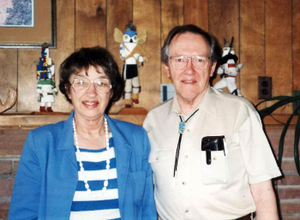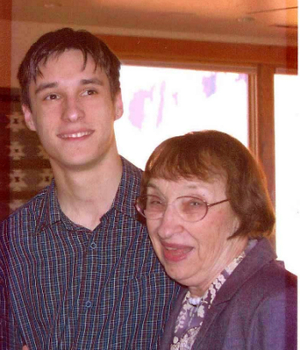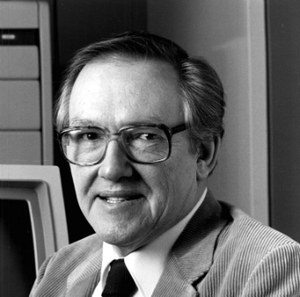Computer pioneer honors wife and grandson with scholarship

“It was an exciting time,” said emeritus professor and philanthropist Harwood G. Kolsky about the early days of the new department of computer engineering at UC Santa Cruz.
“We had about 75 students in that first class and at first we had to share resources with the computer science department (then called a “board of studies”), which was already established in what is now Baskin Hall.” There were other groups in the building. “There was even a dance studio on the upper floor.”
Kolsky was one of the first three professors of computer engineering at UCSC. He taught and managed research projects from 1986 to 1996. Before coming to UCSC, Kolsky was a senior scientist with IBM for 29 years, first in New York and then in the Bay Area.
Kolsky has given $50,000 to establish a scholarship fund at UCSC in memory of his wife, Frances G. Kolsky, and their grandson, Patrick A. Kolsky. Patrick was a freshman studying computer science at CSU Chico when he passed away unexpectedly. The Patrick A. Kolsky Endowed Scholarship will support promising engineering undergraduate students at the Jack Baskin School of Engineering.

Kolsky grew up on the Great Plains of Western Kansas during the Depression. His grandfather immigrated from Bohemia (now the Czech Republic) in 1879, seeking personal freedom and the chance to own land. He later sent for his wife and four children. “Pioneer life was very hard, but they prospered,” said Kolsky.
“My mother always insisted that education was my path to success,” he added. “I was helped by three scholarships to get through school so I know how important they can be.”
He met Frances while they were students at the University of Kansas, although their families had known each other for much longer. Her family had also left Bohemia for a better life for their families. Frances and Kolsky graduated from the University of Kansas in 1943. Kolsky received a B.S. degree in engineering physics.
After graduating, Kolsky served three years In World War II in the U.S. Army, as a cryptographer. In 1944 he participated in the invasion of the Marianas Islands in the Pacific Theater. The Marianas were the staging areas for later assaults on Iwo Jima and Okinawa. He remembers the horrors of war. “They burn in one’s memory,” said Kolsky. “A lot of Japanese civilians were driven to commit suicide by jumping off the cliffs into the ocean.”
Using the GI Bill he earned his Ph.D. in physics from Harvard University. His first position was with the Los Alamos National Laboratory, where he became a pioneering user of large computers.

In 1957 he moved to IBM in Poughkeepsie, New York, joining the “Project Stretch” group planning a new super computer. He transferred to the IBM San Jose Research Laboratory and later became a manager at IBM’s Palo Alto Scientific Center. He was named an IBM Fellow in 1969.
During his career with IBM he directed a variety of research and development projects including programming languages, microprogramming, scientific applications, and digital image processing.
After retiring from IBM he began his new career in the new computer engineering department at UCSC, where he taught courses in computer architecture. He has an interesting story about what brought him to UCSC.
One of Kolsky’s jobs at IBM was to lead review teams to visit IBM scientific centers around the world. One visit was to the German scientific center in Heidelberg. “I got a bright young scientific expert to go with me–who happened to be Pat Mantey.” They had a long day of meetings and then dinner at a bier stube. As they were walking along the main street, Hauptstrasse, lined with 19th century buildings, Pat told him that he had been approached to set up a new department (then called a “board of studies”) in computer engineering. They discussed the details. “I think you should take the job (as chairman),” said Kolsky, “and I’ll come and work for you.” And a year later it happened. The third founding faculty member of the department was Alexander Brandwyn, and Glen Landgon joined soon after.
“I didn’t come to UCSC to retire. In some ways, I worked harder because although you become an expert in one area in industry, you don’t have the broad background needed to teach. The first time one teaches a course, it’s very involved.” Kolsky set up his classes with the same constraints one would find in industry, creating a real-world environment to challenge his students.
In 1989, he initiated a new course, “History of Computing,” at UCSC. “This really forced me to go back and re-read the old reports and to appreciate what a major effort Stretch really was, especially in terms of technical innovation.” Project Stretch was famous for contributing many innovations to computer architecture. While the IBM 7030 was not considered commercially successful, it spawned many technologies incorporated in future machines and microprocessors. Stretch was the fastest computer in the world from 1961 to 1964. Incidentally, it was one of the members of the Stretch project (Werner Buchholz) who came up with the word “byte.”
The Patrick A. Kolsky Endowed Scholarship is not Kolsky’s first act of philanthropy and service. He has generously supported both UCSC and the University of Kansas. In 2006, he donated to help establish the UCSC Senior Design Capstone Project Contest in computer engineering. He also served as a judge for the first contest, which challenges students to work in cross-disciplinary teams to create working prototypes. In 2013 he received the Colfax award from the Odd Fellows of California for “distinguished and exemplary service” at the Saratoga Retirement Community, where he now lives.
The state motto of Kansas is Ad astra per aspera (To the stars through difficulties). “It’s been my motto too,” said Kolsky. “I’ve lived the American dream.”